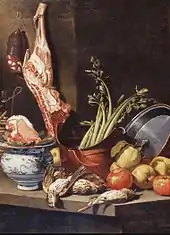Croatian cuisine
Croatian cuisine is heterogeneous and is known as a cuisine of the regions, since every region of Croatia has its own distinct culinary tradition. Its roots date back to ancient times. The differences in the selection of foodstuffs and forms of cooking are most notable between those in mainland and those in coastal regions. Mainland cuisine is more characterized by the earlier Slavic and the more recent contacts with Hungarian and Turkish cuisine, using lard for cooking, and spices such as black pepper, paprika, and garlic.[1][2] The coastal region bears the influences of the Greek and Roman cuisine, as well as of the later Mediterranean cuisine, in particular Italian (especially Venetian). Coastal cuisines use olive oil, herbs and spices such as rosemary, sage, bay leaf, oregano, marjoram, cinnamon, clove, nutmeg, and lemon and orange rind. Peasant cooking traditions are based on imaginative variations of several basic ingredients (cereals, dairy products, meat, fish, vegetables, nuts) and cooking procedures (stewing, grilling, roasting, baking), while bourgeois cuisine involves more complicated procedures and use of selected herbs and spices. Charcuterie is part of the Croatian culinary tradition in all regions. Food and recipes from other former Yugoslav countries are also popular in Croatia.
| Part of a series on the |
| Culture of Croatia |
|---|
 |
| People |
| Literature |
| Sport |
|
Croatian cuisine can be divided into several distinct cuisines (Dalmatia, Dubrovnik, Gorski Kotar, Istria, Lika, Međimurje, Podravina, Slavonija, Zagorje) each of which has specific cooking traditions, characteristic for the area and not necessarily well known in other parts of Croatia. Most dishes, however, can be found all across the country, with local variants.
Meat and game
- Specialities from the grill are called s roštilja, those roasted on the spit s ražnja
- pečeno means roasted
- prženo means fried
- pod pekom means that the dish has been put into a stone oven under a metal cover. The cook puts hot coals on the cover so that the meal is cooked slowly in its own juices. Specialties cooked pod pekom include lamb, veal, and octopus.
- na lešo means boiled in broth or water (lamb, beef, fish)
.JPG.webp)
Croatian meat-based dishes include:
|
|
Seafood

Croatian seafood dishes include:
|
|
Stews
Stewed vegetables with a small amount of meat or sausages (varivo or čušpajz) is perceived as a healthy, traditional meal. Sour cream (in Northern Croatia) or olive oil (on the coast) can be added to the plate just before serving. Stewed meat dishes are often prepared by men in open spaces, following hunting and shepherding traditions. In Dalmatian urban cuisine, spices such as cinnamon and clove, dried plums, dried figs, apples and other fruit are sometimes added to meat stews.

|
|
Pasta
Pasta is one of the most popular food items in Croatian cuisine, especially in the region of Dalmatia. Manistra na pome (pasta with tomato sauce) is a staple. The other popular sauces include creamy mushroom sauce, minced meat sauce and many others. Fresh pasta (rezanci, krpice) is added to soups and stews, or prepared with cottage cheese, cabbage, even with walnuts or poppy seed. Potato dough is popular, not only for making njoki (gnocchi), but also for making plum or cheese dumplings which are boiled, and then quickly fried in breadcrumbs and butter.
|
|
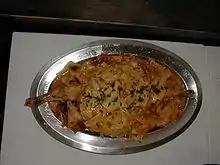

 Žganci
Žganci
Soups
Soup is an integral part of a meal in Croatia and no Sunday family meal or any special occasion will go without it. The most popular soups are broth-based, with added pasta or semolina dumplings. They are usually light in order to leave space for the main course and dessert to follow. However, cream or roux-based soups are also popular, and there are many local variations of traditional soups. In Dalmatia, fish soup with fish chunks, carrots and rice is commonly served.
- Maneštra
- Veal soup with smoked meat
- Beef broth with vermicelli pasta
- Mushroom soup, especially with porcini
- Dill soup
- Zagorska juha with porcini mushrooms, bacon, sweet pepper
- Prežgana juha
- Chicken soup
Side dishes
- Sataraš (sliced and stewed summer vegetables)
- Mlinci (typical northwest Croatian, roasted flatbread, similar to Caucasian flatbreads)
- Đuveč (baked summer vegetables, similar to Ratatouille)
- Šalša od pomidora (tomato salsa)
- Restani krumpir (cooked potato fried with onion)
- Blitva s krumpirom (cooked chard and potato, with olive oil and garlic)
- Povrće na lešo (boiled vegetables seasoned with olive oil, salt and sometimes garlic) is a common way of preparing chard, kale, cabbage, green beans, potato, cauliflower, carrots, broad beans, zucchini and other vegetables as a side dish. It combines well with boiled eggs, as a lighter alternative to a meat- or fish-based meal.
Other
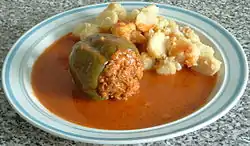

|
|
Sausages and ham
|
|
Cheese (sir)
- Paški sir – famous sheep's milk cheese from island of Pag
- Farmers' cheese (škripavac) and curd cheese from the regions of Kordun and Lika
- Cheese from the Cetina region Cetinski sir
- Cheese from the Island of Krk Krčki sir
- Cheese from Međimurje Turoš
- Cheese from Podravina Prga
- Cottage cheese (eaten with cream, vrhnje) from Zagorje (sir i vrhnje, often seen as quintessential Croatian traditional food)

Savoury pies
Pastry
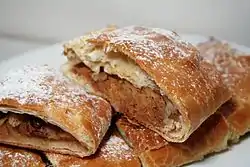


- Bučnica (summer squash and cottage cheese pie, can be savory or sweet)
- Štrukli (made with cottage cheese, sour cream and eggs, can be savory or sweet, boiled or baked)
- Zlevanka, simple baked cornmeal pastry with various fillings (e.g. cheese, sour cream, cherries, plum jam, walnuts, nettle)
- Varaždinski klipići
Sweets and desserts
- Palačinke (crepes) with sweet filling (Hungarian: palacsinta)
- Baklava
- Kremšnita –
- Šaumšnita –
- Zagorski štrukli – sweet pastry from northern Croatia
- Uštipci
- Fritule
- Knedle – potato dough dumplings, usually filled with plums and rolled into buttered breadcrumbs
- Strudel (Croatian: savijača or štrudla) with apple or curd cheese fillings
- Orahnjača and Makovnjača – sweet breads with walnut or poppy seeds
- Croatian honey
- Bear's paw
- Farmer's cheese (quark) cakes (cream cake)
- Krafne, pokladnice – a type of doughnut
- Croatian pancakes (with wine and egg sauce)
- Šnenokli, paradižot (meringue in custard cream, floating island (dessert))
- Almond filled ravioli (rafioli)
- Homemade fruit preserves, jams, compotes
- Čupavci (lamingtons)
Cakes (kolači)
- Rožata or Rozata (flan, creme caramel)
- Easter pastry Pinca
- Kroštule (crunchy, deep-fried pastry)
- Fritule (deep-fried dough, festive pastry, particularly for Christmas)
- Bishop's bread
- Guglhupf ring cake (Croatian kuglof)
- Rapska torta (Rab cake)
- Međimurska gibanica (Međimurje County layer cake with apple, poppyseed, walnut and cottage cheese fillings)
- Makarana torta
- Imotska torta
- Mađarica (Croatian layer cake)
Drinks
Wines
Croatia has two main wine regions: Continental (Kontinetalna) and Coastal (Primorska), which includes the islands. Each of the main regions is divided into sub-regions which are divided yet further into smaller vinogorje, (literally wine hills) and districts. Altogether, there are more than 300 geographically-defined wine-producing areas in Croatia. In parts of Croatia, wine, either red or white, is sometimes consumed mixed in approximately equal proportions with water.
Dessert wines
- Sweet Malvazija
- Muškat Ottonel (see: Muscat grape)
- Prošek
White wines
- Rajnski Rizling
- Žlahtina
- Malvazija
- Graševina
Red wines
Beers (pivo)

Apart from imported beers (Heineken, Tuborg, Gösser, Stella Artois, etc.), there are home-brewed and locally brewed beers in Croatia. A brewery based in Split produces Bavarian Kaltenberg beer by licence of the original brewery in Germany.
- Karlovačko: brewed in Karlovac
- Ožujsko: brewed in Zagreb (the name refers to the month of March)
- Pan
- Favorit: from Buzet, Istria
- Osječko: from Osijek (oldest brewery in Croatia)
- Staro Češko: Czech beer from Daruvar (where a Czech minority lives), brewed in Croatia
- Tars pivo: from the seaport city of Rijeka
- Tomislav: dark beer from Zagreb
- Velebitsko pivo: brewed near Gospić on the Velebit mountain, the dark beer has been voted best beer by an English beer fan website.
Liqueurs and spirits

- Maraschino [6]
- Rakija (Croatian name for spirits), commonly made from: Lozovača / Loza (grapes) (it.: Grappa),Travarica (Loza with herbs), Šljivovica (plums), Kruškovac (pears), Drenovac (cherries)
- Pelinkovac
- Orahovac (walnut liqueur)
- Medovina (honey)
- Gvirc (as Medovina, only more alcohol).
Coffee
Croatia is a country of coffee drinkers (on average 5kg per person annually), not only because it was formerly part of the Austrian-Hungarian Empire, but also because it bordered the former Ottoman Empire. Traditional coffee houses similar to those in Vienna are located throughout Croatia.
Mineral water
Regarding its water resources, Croatia has a leading position in Europe. Concerning water quality, Croatian water is greatly appreciated all over the world. Due to a lack of established industries there have also been no major incidents of water pollution.
See also
References
- "Origin". Absolute Croatia. Retrieved 22 May 2019.
- "Croatian Cuisine Guide: Amazing Croatian Foods You Must Try". CroatiaWise. Retrieved 22 May 2019.
- Bizarre Foods with Andrew Zimmern – Croatia's Dalmatian Coast (youtube) (video). TravelChannelShows. 2015-10-07. Event occurs at 42:34.
- Bizarre Foods - Croatia - Dalmatian Coast.
- "Croatia's Dalmatian Coast: Roasted Rodents & Stone Soup". Travel Channel.
- "Maraska". Maraska.hr. Archived from the original on 2007-08-10. Retrieved 2012-06-20.
- "Badel 1862". Badel1862.hr. 2012-02-14. Archived from the original on 2010-02-17. Retrieved 2012-06-20.
- "Cedevita | Home". Cedevita.hr. Archived from the original on 2015-05-25. Retrieved 2015-11-13.
Further reading
| Wikimedia Commons has media related to Croatian cuisine. |
- "Hrvatska za stolom – mirisi i okusi Hrvatske", Ivanka Biluš et al., Zagreb:Alfa, Koprivnica: Podravka, 1996, 192 p., illustrated in color, (Biblioteka Anima Croatarum, 2) ISBN 953-168-104-X
- "Hrvatska vina" (Croatian wines), Fazinić Nevenko, Milat Vinko, illustrated, 159 p., 1994, ISBN 953-173-061-X
- "Nova hrvatska kuhinja" (New Croatian cuisine), Davor Butković, Ana Ugarković, Profil international, Zagreb, 2005, 272 p., ISBN 953-12-0164-1
- Callec, Christian (2003), written at The Netherlands, Wine: A Comprehensive Look at the World's Best Wine, New York: Random House (published 2002), ISBN 0-517-22165-9.
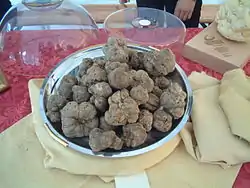
.jpg.webp)

